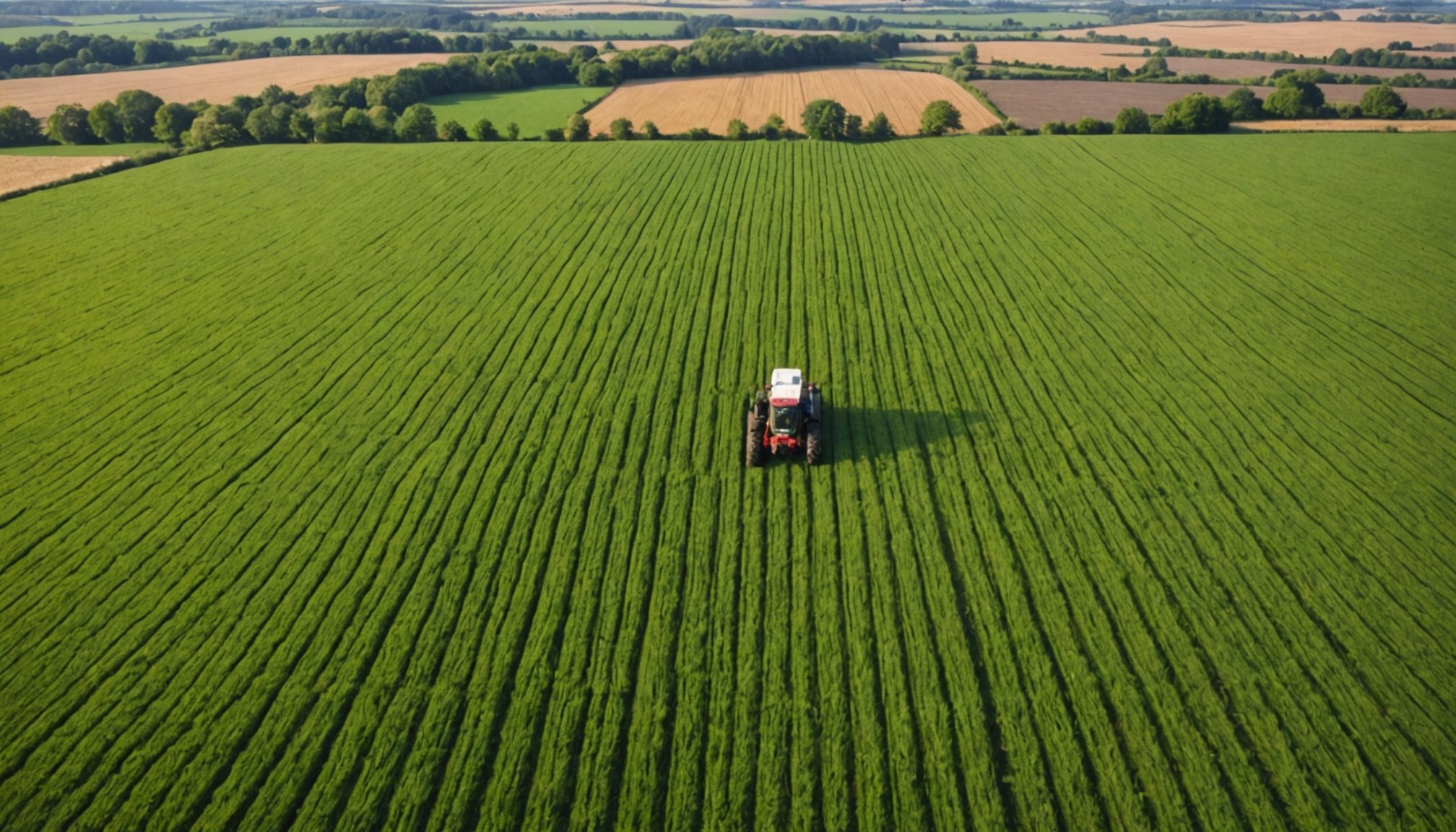Navigating the Financial Challenges of Investing in UK Agricultural Land for Non-Agricultural Purposes
Investing in agricultural land in the UK, especially for non-agricultural purposes, can be a complex and potentially lucrative venture, but it is not without its challenges. Here, we will delve into the various financial risks and considerations that investors need to be aware of when venturing into this domain.
Understanding the Current Landscape
The UK’s agricultural land market is influenced by a myriad of factors, including recent policy changes, environmental concerns, and economic pressures. The decision to invest in agricultural land for non-agricultural purposes, such as extending a garden or creating a smallholding, must be made with a thorough understanding of these factors.
Also to see : Your complete blueprint for successfully opposing a property development project in your uk community
Policy Changes and Their Impact
The recent changes to Agricultural Property Relief (APR) and Business Property Relief (BPR) announced in the Autumn Budget have significant implications for landowners and rural businesses. These changes, aimed at closing tax loopholes for wealthy non-farmer landowners, have sparked concerns among farmers and landowners. As noted by the WWF, “the decision has ignited a tinderbox” of financial and environmental risks for farmers, who are already under pressure from low-cost production demands and environmental challenges[1].
Financial Considerations
Investing in agricultural land involves several financial considerations that can make or break the viability of the investment.
Also read : Unveiling sustainable practices in new uk property developments: a comprehensive exploration
Land Valuation and Pricing
Agricultural land prices vary widely based on factors such as location, land quality, and proximity to urban areas. For instance, land that is highly productive for farming or close to urban areas tends to be more valuable. It is crucial to get an accurate valuation to avoid overpaying for the land. As Wright Hassall advises, “agricultural land prices are often based on how productive the land is (for farming) and its proximity to urban areas”[5].
Financing Options
Securing financing for agricultural land can be more challenging than for residential properties. Investors may need to opt for specific types of loans, which can be more difficult to obtain. Some may use savings, while others might choose secured or unsecured loans or borrow against the value of their current property. The financing landscape is complex, and as Wright Hassall points out, “lenders might not approve a loan for land that is intended for garden use, as it is not income-generating land”[5].
Legal and Practical Implications
Before investing in agricultural land, it is essential to understand the legal and practical implications involved.
Zoning Laws and Boundaries
Agricultural land is primarily designated for farming purposes, and any change in use requires specific permissions. Investors need to ensure that the land has clear boundaries and legal access. Additionally, they must check for any rights of way or easements that could affect the use of the land. For example, a footpath or vehicle access might pass through the land, limiting its development potential[5].
Covenants and Overage Payments
The seller may impose conditions or restrictions on the use of the land, such as prohibitions on building or specific types of building. Investors also need to be aware of overage covenants, which give the seller the right to receive additional payments if the land is developed in the future. Understanding these terms is crucial to avoid unexpected financial liabilities[5].
Environmental Factors and Land Management
Environmental considerations are increasingly important when investing in agricultural land.
Climate Risks
Investors need to understand the physical climate risks associated with the land, such as flooding, land subsidence, and extreme weather events. These risks can impact how the land can be used and managed, as well as its long-term value. As Savills notes, “investing across a range of geographical regions and crop types can lessen the impact of a farmland owner’s exposure to localised weather events such as droughts, flooding and hailstorms”[4].
Land Management and Maintenance
Once the land is purchased, it requires ongoing management and maintenance. This may involve clearing and preparing the land, erecting new boundary fences, and ongoing maintenance tasks. These costs and responsibilities should be factored into the investment decision to ensure that the land remains viable and valuable over the long term[5].
Renewable Energy and Natural Capital Opportunities
Agricultural land can also offer opportunities for renewable energy and natural capital investments.
Renewable Energy
Large agricultural holdings can provide opportunities for solar and wind power generation. Investing in renewable energy can not only generate additional income but also contribute to the UK’s net-zero goals. As Savills highlights, “opportunities exist to build scale in solar and wind power generation, amongst others”[4].
Natural Capital
Agricultural land can be used to achieve natural capital goals, including carbon sequestration. This can provide both environmental benefits and potential financial returns through schemes that reward sustainable land use practices. The WWF emphasizes the need for an “all hands on deck” approach to support regenerative practices and build a resilient food system, which includes leveraging natural capital opportunities[1].
Case Study: The Impact of Policy Changes on Land Use
To illustrate the complexities involved, let’s consider a case study of how recent policy changes are affecting land use in the UK.
The CAP Reform Legacy
The EU’s Common Agriculture Policy (CAP) reforms have had a lasting impact on UK farming. The decoupling of farm income support from production and the introduction of Single Farm Payments led to inflated land prices and discouraged farmers from making space for nature within farms. Since the UK’s departure from the EU, the focus has shifted towards agri-environmental schemes, but the transition has been challenging for many farmers[1].
Current Policy Initiatives
The UK Agriculture Act of 2020 introduced new payment schemes based on the principle of “public money for public goods.” While this transition is seen as positive, it has its pitfalls. The recent Budget announcement to accelerate the phase-out of the Basic Payment Scheme and redirect funds towards Environmental Land Management schemes is a step in the right direction but poses immediate financial risks for farmers if payments are not made swiftly[1].
Practical Insights and Actionable Advice
For those considering investing in agricultural land for non-agricultural purposes, here are some practical insights and actionable advice:
Conduct Thorough Research
Before making any investment, conduct thorough research on the land’s history, current use, and potential risks. This includes understanding the legal, financial, and environmental implications.
Seek Professional Advice
Consult with solicitors familiar with agricultural law and overage covenants to ensure you understand all the terms and conditions of the sale.
Plan for Long-Term Costs
Factor in the long-term costs of land management and maintenance. This includes clearing and preparing the land, erecting new boundary fences, and ongoing maintenance tasks.
Consider Diversification
Diversify your investment by considering different land uses, such as renewable energy or natural capital opportunities. This can help mitigate risks and provide additional income streams.
Investing in agricultural land for non-agricultural purposes in the UK is a complex endeavor that requires careful consideration of financial, legal, and environmental factors. By understanding the current policy landscape, conducting thorough research, and seeking professional advice, investors can navigate these challenges and make informed decisions.
As Scottish Land & Estates advises, “the proposed land reform bill risks discouraging investment in rural businesses and could lead to a reduction in land sales due to the bureaucratic burdens it would introduce.” Therefore, it is crucial to approach such investments with a long-term perspective and a collaborative mindset, working with rural businesses and the government to create a sustainable land market[3].
Detailed Bullet Point List: Key Considerations for Investing in Agricultural Land
- Land Valuation: Ensure accurate valuation based on land productivity and proximity to urban areas.
- Financing Options: Explore specific loans for agricultural land, and consider using savings or secured/unsecured loans.
- Zoning Laws: Understand the current designation of the land and any necessary permissions for change of use.
- Boundaries and Access: Verify clear boundaries and legal access to the land.
- Rights of Way and Easements: Check for any rights of way or easements that could affect land use.
- Covenants and Overage Payments: Understand any conditions or restrictions imposed by the seller.
- Climate Risks: Assess physical climate risks such as flooding, land subsidence, and extreme weather events.
- Land Management and Maintenance: Plan for ongoing costs of clearing, preparing, and maintaining the land.
- Renewable Energy Opportunities: Consider potential for solar and wind power generation.
- Natural Capital Opportunities: Explore possibilities for carbon sequestration and other natural capital goals.
- Professional Advice: Consult with solicitors familiar with agricultural law and overage covenants.
- Long-Term Costs: Factor in long-term costs of land management and maintenance.
Comprehensive Table: Comparison of Key Factors in Agricultural Land Investment
| Factor | Description | Implications |
|---|---|---|
| Land Valuation | Based on productivity and proximity to urban areas | Accurate valuation crucial to avoid overpaying |
| Financing | Specific loans, savings, secured/unsecured loans | Challenging to secure financing; consider multiple options |
| Zoning Laws | Current designation and necessary permissions | Ensure compliance with zoning regulations |
| Boundaries and Access | Clear boundaries and legal access | Essential for uninterrupted use of the land |
| Rights of Way and Easements | Check for any rights of way or easements | Could affect land use and development potential |
| Covenants and Overage Payments | Conditions or restrictions imposed by the seller | Understand terms to avoid unexpected financial liabilities |
| Climate Risks | Physical climate risks such as flooding, land subsidence | Assess and mitigate risks to ensure long-term viability |
| Land Management and Maintenance | Ongoing costs of clearing, preparing, and maintaining the land | Factor in long-term costs to ensure sustainability |
| Renewable Energy Opportunities | Potential for solar and wind power generation | Additional income streams and contribution to net-zero goals |
| Natural Capital Opportunities | Possibilities for carbon sequestration and other natural capital goals | Environmental benefits and potential financial returns |
Relevant Quotes
- “The proposed land reform bill risks discouraging investment in rural businesses and could lead to a reduction in land sales due to the bureaucratic burdens it would introduce.” – Scottish Land & Estates[3]
- “Farmers should not be expected to solve the problem alone and shoulder the costs of the transition to more regenerative farming.” – WWF[1]
- “Investing across a range of geographical regions and crop types can lessen the impact of a farmland owner’s exposure to localised weather events such as droughts, flooding and hailstorms.” – Savills[4]
By carefully considering these factors and taking a holistic approach to investment, individuals can navigate the complexities of investing in UK agricultural land for non-agricultural purposes and make informed, sustainable decisions.











